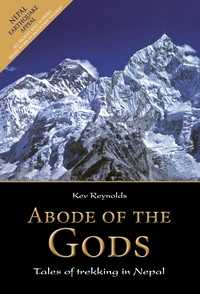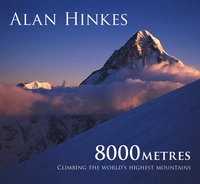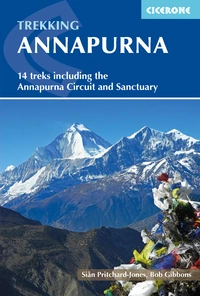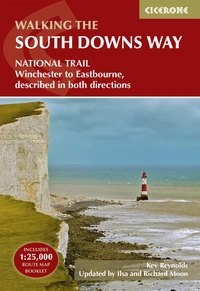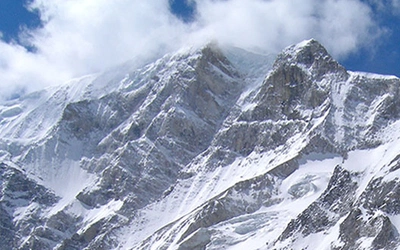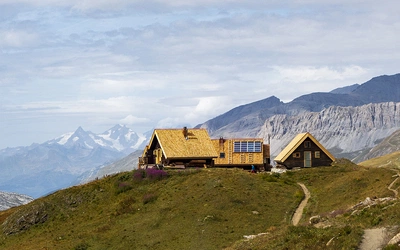Dolpo: Nepal's Hidden Region Powered by Yak Dung
In this extract from his inspirational memoirs about trekking in the Himalaya, Abode of the Gods, Kev Reynolds describes the moment when he reached Nepal's remote Dolpo region for the first time.
Abode of the Gods
Tales of Trekking in Nepal
£19.95
An inspirational book capturing the wonders of trekking in Nepal, in eight vivid stories from Kev Reynolds' journals exploring the Himalaya. Landscape, people, sounds and smells come to life as they are encountered for the first time in the Everest, Annapurna, Langtang, Kangchenjunga, Manaslu, Dolpo, Mugu and the far west of Nepal.
More informationThe twin-engined aircraft Kirken has chartered to get us to the south side of the mountains has only eight seats, the rest having been removed to make way for large sacks of rice due to be transported to impoverished villages in some far-distant valley. Where we’re going is one of the highest permanently inhabited regions on Earth, a land where the annual harvest is insufficient to feed the whole population, so I guess this rice is destined, as we are, for the northern side of the Himalayan divide. Out there, I anticipate a very different world, for the Himalayas form a barrier not only between landscapes and vegetation, but – with all its Tibetan influences – between cultures and racial identities. Dolpo will be a far cry from the humid lowlands of the Terai we’ve just left behind, where squadrons of mosquitoes gathered at dusk and the sticky heat made sleep all but impossible to achieve. Nepalgunj, where we spent the night just a few kilometres from the Indian border, was not my kind of town, and delay after delay there made us all edgy. But now at last we’re dodging clouds as the flat lands below give way to hills that rise to bigger hills, and mountains dashed with snow appear through holes in those clouds.
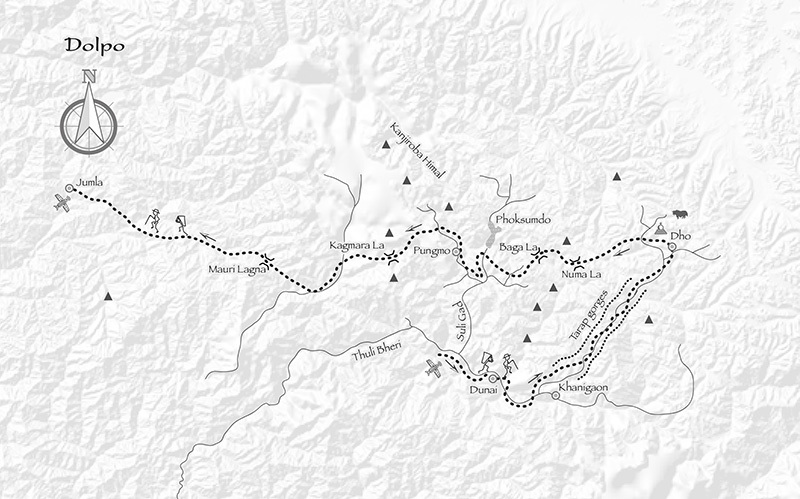
We’re slow to move today, for the routine of life on trek has to be learned by the rest of the group – bed-tea brought to the tent at 6 o’clock, followed by a shallow bowl of warm washing water; breakfast served shortly after 6.30, by which time kitbags should be packed and ready for the porters. While breakfast is eaten, the tents are collapsed and porters set off with their loads. Most days we’re on the move shortly after 7.30; lunch is taken any time between 10.30 and 1 o’clock, depending on the availability of water; then we wander on through the afternoon until camp is pitched at around 4 o’clock. There’s tea, coffee, hot chocolate and a few biscuits in the late afternoon, followed by dinner at six, and by eight most of us will be in our tents, dead to the world.
Ten hours in a sleeping bag! I think it was Tilman who once commented that the biggest health problem for the Himalayan traveller was bed sores. A bit of an exaggeration, of course, but nowhere else do I spend so much of my time in a horizontal position.
One morning we rise to find mist draped in the valley like an old lace curtain, the cliffs above our camp black and shining from overnight rain. A cold wind rushes along the river; surly and uninviting, it reminds me of wintry days in Snowdonia. But it was there and on such days that my passion for mountains and wild country was formed. Without them, perhaps, I would not be here today.
It rains for most of the morning. The temperature drops and sleet bounces off our waterproofs, but in the early afternoon conditions improve and sunlight explodes into the valley before the gorge makes a sharp bend and shadows fill the narrow spaces between walling cliffs. The sound of voices ahead echoes from wall to wall, and moments later we come across Dorje, one of our Sherpas, in conversation with Kirken’s brother and two porters removing sheets of polythene from their dokos. ‘Hey Baje!’ cries one of the porters, and I flush with pleasure. The man whose name I do not know acknowledges me as his friend.
Where there’s vegetation autumn is evident in every leaf, but with each hour of progress towards the hidden land, there’s less of it. We’re being squeezed by Himalayan mountains, and our eyes are attracted by different types of rock. I’m no geologist, but recognise sandstone, limestone and patches of conglomerate, and when we cross a minor pass within the confines of the gorge we find curious eroded lumps and domes of clay.
Once again our map is the product of a rich imagination, but I’ve grown used to fictional Himalayan routes drawn on poor quality paper, and rarely refer to it except at the end of the day, when Kirken and I will pore over it to speculate where we are and where we might be tomorrow. He came here with a naturalist several years ago to study the snow leopard, and remembers much of the route, although he’s baffled by many of the names on the map and has little trust in its authenticity. This evening, though, he is adamant. ‘Tomorrow’, he tells us, ‘we reach Dho Tarap.’
A final bridge takes us across the Tarap Khola out of shadows and into the warmth of a new day. Some of our porters are resting in the sunlight and, taking the hint, we remove a layer of clothing and sit for a few minutes with them. A circular, intricately carved mani with Buddhist motifs instead of Sanskrit letters leans against a crag. Prayer flags can be seen on the crest of a ridge high above us; everyone falls silent.
Excitement spurs me on and, emerging through the natural gateway at the head of the gorge, my eyes light upon the real Dolpo at last. Reality does not disappoint as I stand here a little moist-eyed and breathless, and gaze into a broad valley flanked by big brown hills lightly dusted with snow. A young boy wanders to and fro through the valley, stooping every now and then to lift something that he tosses over his shoulder into a small doko. What could he be gathering, I wonder?
At last I’m face to face with the boy, and peering into his doko I see it half-filled with dried slabs of yak dung. Of course! It’s fuel for cooking and heating the homes. At around 4000 metres above sea level, this valley – like so many others this side of the Himalaya – is too high for trees to grow, so there is no firewood. There’s neither gas nor electricity; no coal nor oil. The only fuel is that left by grazing animals. So each morning the children are sent out to scour the valley and lower hillsides to gather yak dung, while manure from sheep and goats will fertilise the soil for growing barley, buckwheat and potatoes. There can be no waste in this impoverished land.
The boy looks up at me, furrows his brow and tilts his head. How old is he? Perhaps nine or ten – who can say? His face has been blackened by seasons of raw winds and high-altitude sun, but when his homespun tunic opens at the chest, I note that his flesh is not much different in colour to my own. He seems just as bemused by my appearance, and in response to my ‘Namaste’ he offers a brief momentary smile before deserting me to inspect the rest of the group.
Kirken and I watch the others as they descend below snow-dusted peaks that tower over the bare hills of the Jagdula Lekh and are then swallowed by a dense bank of rhododendrons. He and I are reluctant to move, so we sit side by side and let the moments pass. The last sounds of porters working their way through woodland far below fade into the stillness of the morning. A bird calls; another answers. Then silence.
Far ahead, beyond converging ridges that fold one against another, a great block of snow and ice hangs in the sky. Divorced from its roots by a skein of mist, it has no connection with the Earth, but hovers like a cloud bank untouched by any shifting wind. I’m mesmerised by it.
‘What’s that?’ I ask Kirken.
He looks over his shoulder, checking to see if anyone is within earshot. There’s no one. We are alone.
Leaning closer until our shoulders press, he taps the side of his nose, and in a strage whisper tells me.
‘Saipal. I must go there!’
And with those five words another dream is born…
Abode of the Gods
Tales of Trekking in Nepal
£19.95
An inspirational book capturing the wonders of trekking in Nepal, in eight vivid stories from Kev Reynolds' journals exploring the Himalaya. Landscape, people, sounds and smells come to life as they are encountered for the first time in the Everest, Annapurna, Langtang, Kangchenjunga, Manaslu, Dolpo, Mugu and the far west of Nepal.
More information

